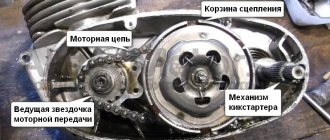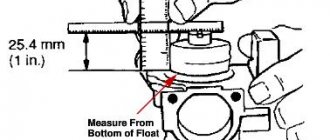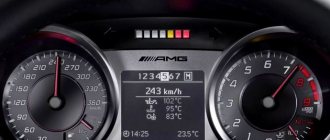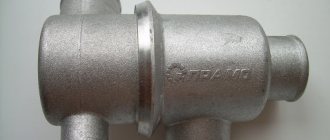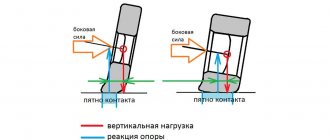Engine operating cycle, working strokes
Internal combustion engines, which appeared a long time ago, both running on gasoline and diesel fuel, and used now, are divided into two types:
- Two-stroke;
- Four-stroke.
As can be seen from the name, the difference in the operating principle of the engine is reduced to the number of strokes - piston movements during which it performs a certain cycle of work.
For a four-stroke engine, 4 strokes are defined, as a result of which one piston performs a full cycle - intake, compression, power stroke and exhaust.
In each of these cycles, certain processes are performed in the engine cylinder. All of them are aimed at achieving one goal - ensuring the conversion of fuel combustion energy into rotation of the crankshaft.
So, during the intake stroke, a combustible mixture consisting of fuel and air is supplied to the cylinder, without which the combustion process is impossible. Moreover, the formation and supply of this mixture is different for gasoline and diesel engines.
Next comes the compression stroke
, at which the incoming mixture is compressed in volume. This is done so that more combustible mixture is formed in a smaller volume.
Reducing the volume allows the next stroke to provide higher efficiency during fuel combustion.
Working stroke
- the only one of all the beats, during which energy is given and not taken away, and for it all other beats exist.
After compression, the mixture ignites; in gasoline engines, due to a spark jumping between the electrodes of the glow plug; in diesel engines, due to high pressure, at which the mixture heats up so much that it ignites.
When the mixture ignites, energy is released, which acts on the piston, causing it to move downward, while the energy released from combustion is transferred by the piston to the crankshaft via a connecting rod.
Release
- a stroke aimed at cleaning the cylinder cavity from combustion products. After cleaning, the cycle repeats again.
From all of the above, it turns out that one cycle of movement of the piston in the cylinder is aimed only at obtaining one stroke - the power stroke, all other strokes only help to obtain it, and for their implementation part of the energy that is given off by the power stroke is used.
Each engine stroke corresponds to a specific movement of the piston in the cylinder.
There are two extreme points of the piston position, called dead points.
One of them is upper - the piston cannot rise higher in the cylinder, and the second is lower, in which it does not fall lower.
These points are provided by the crank of the crankshaft, to which the piston is connected by a connecting rod.
When the piston moves from one point to another, and then vice versa, strokes are performed. That is, when the piston moves from the bottom point ( BDC
) to the top (
TDC
), two strokes can be performed - compression and exhaust, and when moving vice versa - intake and power stroke.
Having an idea about strokes, we can talk about the types of engines, and there are two of them - 2-stroke and 4-stroke.
Each of these engines cycles differently, which affects their design and many other parameters and characteristics.
Operation of a two-stroke unit
Although this is not what this article is about, it is worth briefly describing the functioning of a two-stroke engine in order to compare them. As is clear from the name, the functioning of such a motor takes place only through two strokes.
- The piston moves upward, which leads to compression of the combustible mixture, after which (without reaching top dead center) it ignites. When the piston reaches top dead center, the intake windows in the cylinder wall open, causing the combustible mixture to flow into the crank chamber.
- Under the influence of stretching gases, the piston moves to the lower side. Being in the lower position, the piston opens the intake and exhaust windows. Gases enter the exhaust pipe, and in their place is a combustible mixture.
–> Interpretation STROKES OF INTERNAL COMBUSTION ENGINESTACTS OF INTERNAL COMBUSTION ENGINE
- individual processes occurring in the cylinder during one stroke of the piston and constituting the full operating cycle of an internal combustion engine. For example, in a four-stroke engine, the working processes (suction, compression, power stroke and exhaust) that make up the work cycle are completed in 4 piston strokes, and in two-stroke engines in 2 strokes. See also Internal combustion engines.
Samoilov K. I. Marine dictionary. – M.-L.: State Naval Publishing House of the NKVMF of the USSR, 1941
Design and principle of operation of a 2-stroke engine
The 2-stroke engine is most widely used in small equipment (chainsaws, lawn mowers) and motorcycles.
Once upon a time there were even 2-stroke diesel engines installed on trucks, for example, the MAZ-200.
It is interesting that the strokes described above have not disappeared from any two-stroke engine, they have simply been combined.
As a result, this allows you to reduce the full cycle in just one rotation of the knees. shaft
So, when the piston moves from BDC
two strokes are performed at once - exhaust and compression, and when moving from TDC - intake and power stroke.
All this can be achieved by using windows in the cylinders, through which the fuel mixture is sucked in and pumped, as well as combustion products are removed.
The opening and closing of these windows is ensured by the piston itself. To ensure the correct operation of the mechanism, the windows are located at different levels in the cylinder walls.
To make it more clear, let’s take the engine of the IZH Planet 5 motorcycle.
This motorcycle is equipped with a single-cylinder two-stroke engine.
The cylinder is located on top of the engine housing, it is cooled by air, so it has cooling fins around its circumference.
On the one hand, a pipe coming from the carburetor is attached to the cylinder, through which the combustible mixture enters the cylinder.
Opposite this pipe, an exhaust gas exhaust pipe is installed.
At the top of the cylinder is covered by a head in which the glow plug is located.
Inside the cylinder there is a piston connected to the crankshaft crank through a connecting rod. Further, it is already connected with the clutch and transmission, but this is not important yet.
To supply fuel to the above-piston space in a two-stroke engine, the under-piston space is also used.
When the piston moves upward, a vacuum is created in the sub-piston space, into which the air-fuel mixture is sucked through the inlet window.
The supply from the sub-piston space to the above-piston space is produced from the excess pressure that occurs when the piston moves downwards.
Fuel is supplied through the bypass window. The combustion products are released through the outlet window.
Now how does it all work.
Let's start with the movement of the piston to TDC. Being at BDC, the piston ensures the opening of the bypass and exhaust windows. Excessive pressure in the sub-piston space pushes the combustible mixture into the supra-piston space.
Moving upward, the piston closes the open windows, as a result of which the combustion chamber becomes sealed.
Reaching TDC, the piston compresses the mixture and then a spark is supplied from the glow plug, which is installed in the cylinder head.
At this time, the piston moving upward opens the inlet window through which the mixture enters the sub-piston space. That is, it turns out that in one stroke - the movement of the piston from BDC to TDC - two actions occur: first, fuel intake, then compression.
After the fuel ignites, the energy released pushes the piston down.
Moving down from TDC, the piston first opens the exhaust port. During combustion, the volume of combustion products increases significantly, so they immediately begin to escape through this window.
It turns out that when the piston moves downward, the power stroke is performed first, and after the exhaust window is opened, the exhaust stroke is also performed.
Then, when the piston moves down, it opens the bypass window and fuel begins to flow into the space above the piston - the cycle begins to repeat, while the entire cycle required only the movement of the piston, first up and then down, which corresponds to one revolution of the knees. shaft
Issue - four-stroke engine
After BDC of the power stroke of a four-stroke engine , the exhaust valve opens and the rising piston forces the exhaust gases out of the engine cylinder. When the piston reaches TDC, the exhaust valve closes and the four-stroke cycle begins all over again.
It must also be remembered that the next process (for example, admission) does not necessarily have to begin at the moment when the previous one (for example, exhaust) ends. This position, when both valves (intake and exhaust) are open at once, is called valve overlap. Valve overlap is necessary for better filling of the cylinder/s with the combustible mixture, as well as for better cleaning of the cylinder/s of a four-stroke engine from exhaust gases.
| Four-stroke scooter engine: 1 - cylinder with head 2 - cylinder head cover 3 - carburetor 4 - inlet pipe 5 - electric starter. |
For even greater clarity, watch a video that clearly shows the operation of a four-stroke engine. This video demonstrates a four-cylinder car with sixteen valves (that is, each cylinder has two intake and exhaust valves, for better purging) engine, but this does not change the essence.
In two-stroke engines, all operating cycles (the processes of injecting the fuel mixture, exhausting exhaust gases, purging) occur during one revolution of the crankshaft (and not two, as in four-stroke engines) in two (and not four) main strokes. Two-stroke engines do not have valves (as in four-stroke internal combustion engines); their role is played by the piston itself, which, in the process of movement, either closes or opens the intake, exhaust and purge windows. Therefore, a two-stroke engine is simpler in design.
The power of a two-stroke engine with the same cylinder dimensions and shaft speed is theoretically twice that of a four-stroke engine due to the twice as many power strokes. However, incomplete use of the piston stroke of a two-stroke engine for expansion, poorer release of the cylinder from residual gases and the expenditure of part of the generated power on purging lead to an increase in power by only 60 - 70%.
So, consider the design of a two-stroke internal combustion engine , shown in Figure 1:
A two-stroke engine consists of a crankcase in which a crankshaft and cylinder are mounted on bearings on both sides.
Lubrication of all rubbing surfaces and bearings inside two-stroke engines occurs due to the fuel mixture - a mixture of gasoline and oil in a certain proportion. From Figure 1 it can be seen that the fuel mixture (yellow color) enters both the crank chamber of a two-stroke engine (the cavity where the crankshaft is fixed and rotates) and into the cylinder. There is no lubricant there anywhere, and if there was, it would be washed off with the fuel mixture. This is the reason why oil is added in a certain proportion to gasoline. The type of oil used is special, specifically for two-stroke engines. It must be able to withstand high temperatures and, when burned together with the fuel, leave a minimum of ash deposits, that is, soot.
Now about the principle of operation. The entire working cycle in two-stroke engines is carried out in two strokes.
Operating principle of a 4-stroke engine
Now about the operating principle of 4-stroke engines. Let's take a single-cylinder motorcycle engine again, but this time it's a Honda CB 125E.
This engine also has a cylinder located above the crankcase and is air-cooled.
Inside the cylinder there is a piston connected to the crankshaft via a connecting rod. The top of the cylinder is closed by a head.
A design feature of this engine is the presence of a mechanism that ensures the supply of the mixture and the removal of combustion products - a gas distribution mechanism.
This motor is installed in the block head. The essence of this mechanism is the timely opening of the inlet and outlet windows, which are closed by valves.
Everything works according to this principle. First, the intake stroke. To ensure this stroke, the piston must move from TDC down. In this case, the valve opens the inlet window, through which fuel is sucked into the cylinder by vacuum.
After reaching BDC, the intake window closes with the valve, at this time the piston begins to move upward, and the compression stroke begins.
During this stroke, both windows are closed, the cylinder is completely sealed, and the piston, when moving upward, compresses the combustible mixture that entered earlier.
When the piston approaches TDC, when the mixture is compressed to the maximum, it is ignited by a spark from a spark plug.
Excessive pressure during combustion forces the piston to move downward - a working stroke occurs, during which the windows also remain closed.
After reaching BDC, the piston begins to move upward, at this moment the valve opens the exhaust window and the piston pushes combustion products through it.
As a result, it turns out that one revolution of the knees is needed to perform the intake and compression strokes. shaft, and for the power stroke and release - one more revolution.
These were the principles of operation of 2-stroke and 4-stroke engines using the example of motorcycles.
These principles are used on all internal combustion engines - from a model aircraft engine to a powerful 12-cylinder tank engine.
Unit design
The design of a 4-stroke engine looks like this: the camshaft is located in the cylinder cover and is driven by a drive wheel mounted on the crankshaft. In a 4-stroke engine, the camshaft is capable of opening and closing the intake and exhaust valves, but only one of them, and which one specifically depends on the location of the piston. In addition, cams are located on the camshaft, with the help of which the valve rocker arms are actuated.
After their actuation, the rocker arms begin to act on one of the two valves, which leads to its opening. It is worth noting that there must be a narrow gap between the valve and the adjusting screw (it is also called a thermal gap) - during heating, the metal expands, therefore, if there is no or too small gap, the valves will not be able to completely close the intake and exhaust channels. The clearance at the exhaust valve must be larger than that at the intake valve, since the exhaust gases are hotter than the combustible mixture, and, accordingly, this leads to the fact that the exhaust valve heats up more than the intake valve.
That's all the description of the 4-stroke engine.
Design features
In addition to differences in operating principles, these motors also have design features.
The 2-stroke engine is structurally simpler. The gas distribution mechanism is an additional engine equipment that complicates the design.
A 2-stroke engine does not have this mechanism and its role is played by the piston, opening and closing certain windows.
In addition, this engine does not require a lubrication system. This is due to the fact that the under-piston space, where the knees are located, is also involved in the work process. shaft.
But since the crank mechanism requires lubrication, in this engine it is produced together with fuel, that is, engine oil is added to the fuel, and when fuel enters this space, the existing oil lubricates the mechanism.
For 4-stroke engines, the design includes both a gas distribution mechanism and a separate lubrication system.
This significantly complicates the design, however, these engines are a higher priority than two-stroke engines due to a number of operational shortcomings of the latter.
Peculiarities
Power equipment operates based on the expansion of gases when heated, which occurs when the fuel entering the inside of the cylinder ignites. Many people are of the opinion that the Briggs Stratton 4-stroke engine has better performance. To get a clear answer, it is worth understanding the operating features of both types.
The crank-connecting rod design and the mechanism responsible for gas distribution are the main components, no less important systems that provide lubrication of elements, ignition and power.
The crank device transmits the necessary impact of expanding gases, while the mechanism that distributes them supplies gasoline into the cylinder space.
The 4-stroke engine is characterized by economical fuel consumption, the absence of flammable mixtures in the exhaust, a lower level of reproduced noise, and also environmental friendliness, due to which it has become widespread among many companies involved in the production of automobiles.
Performance indicators
Now about the performance indicators.
Liter capacity.
In many ways, 2-stroke engines are better in these respects. The energy expended and received to complete one work cycle affects.
With a 2-stroke engine, each revolution is one full cycle, which provides more liter power - the ratio of cylinder volume to power output. On average, the liter power of a 2-stroke engine is 1.5 times higher than that of a 4-stroke engine.
Specific power.
Another indicator in which a 2-stroke engine is superior to a 4-stroke engine is specific power.
This indicator characterizes the ratio of output power to the total weight of the engine.
While losing in power terms, the 4-stroke engine is better in terms of fuel consumption.
It supplies the mixture in doses, through the inlet window, while the outlet is closed.
With a 2-stroke engine, there is a moment when the exhaust and bypass windows are open, while the incoming fuel partially exits through the outlet window along with combustion products, that is, part of the fuel does not participate in the process, but simply flies out into the atmosphere.
Positive and negative sides
The mechanism has a sufficient number of disadvantages, including high fuel consumption, with most of it going to waste. This is caused by the partial release of a mixture of vapors during the simultaneous opening of the exhaust and purge windows. It is also necessary to note the continuous consumption of oil, since it is part of the mixture and without it the engine cannot operate. Another negative side is the continuous preparation of the fuel mixture.
The two-stroke mechanism has light weight and dimensions, which a 4-stroke engine cannot boast of. But during the operation of the car, it causes more problems, which is why this option is common in the modeling field, where special importance is attached to every extra kilogram.
Lubricants
Due to the differences between engines, automobile oils must meet different requirements:
- oil for a four-stroke mechanism must have high lubricating properties that remain the same for a long time;
- for another type, maximum combustion of the lubricant is required with minimal residual effects in the form of soot and ash.
In the early days of engines, conventional distillation of petroleum products was used to produce lubricant. Moreover, the composition was the same for both options. The need to create new oils did not arise due to the fact that the 4-stroke engine had low power, and as a result, minor wear and low loads on the components. Later, the reserve of trains was exhausted by a gradual increase in speed during operation and general parameters. This problem was solved by using additives - special additives for automobile oils. Even today they significantly improve the performance of the lubricant.
Main difference
As noted above, the two types of engines have a fundamental difference, which lies in the lubrication of two-stroke mechanisms, which is carried out with a mixture of gasoline and oil, which subsequently burns. Some of them have a special system that supplies oil to the crankcase, but the meaning remains the same - gasoline burns along with the oil. While the Chinese 4-stroke Lifan engine, like any other similar engine, is equipped with devices for returning oil to a special compartment.
